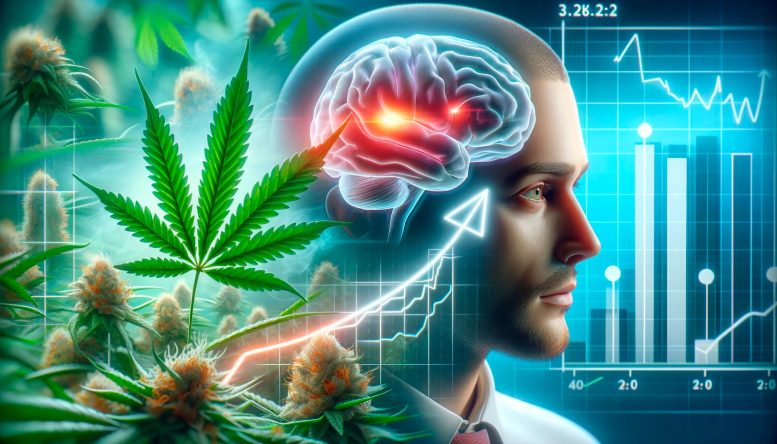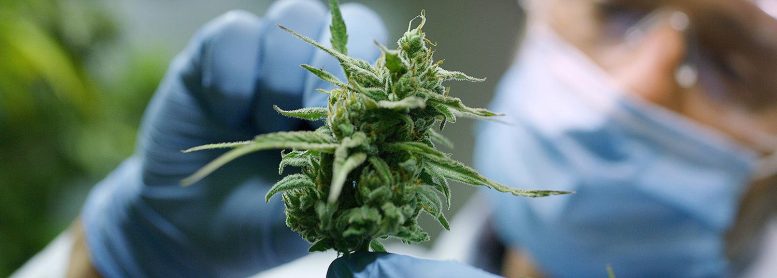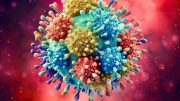
A research review in the New England Journal of Medicine highlights the growing concern over cannabis use disorder, exacerbated by increased cannabis potency and usage. This disorder, affecting a significant portion of Americans, particularly young adults, is often accompanied by other psychiatric conditions. Credit: SciTechDaily.com
Review article published in the New England Journal of Medicine finds 16 million Americans have cannabis use disorder.
The widespread use of cannabis (marijuana) and its increased potency are associated with a rise in cannabis-related psychiatric conditions, according to a new University of Maryland School of Medicine (UMSOM) review article that was recently published in the New England Journal of Medicine. It highlights the urgent need for doctors to screen for and treat patients who are experiencing symptoms of cannabis use disorder, which means they are experiencing significant problems from their use of the drug.
Nearly one in five Americans ages 12 and older used cannabis in 2021, according to the article, and more than 16 million met the criteria for cannabis use disorder as outlined in the American Psychiatric Association’s Diagnostic and Statistical Manual of Health Disorders (DSM-5-TR). Young adults ages 18 to 25 are disproportionately affected. The review found more than 14 percent of those in this age group had cannabis use disorder.
Misconceptions and Risks of Cannabis Use
“There is a lot of misinformation in the public sphere about cannabis and its effects on psychological health with many assuming that this drug is safe to use with no side effects,” said David A. Gorelick, MD, PhD, Professor of Psychiatry at UMSOM who wrote the review article. “It is important for physicians and the public to understand that cannabis can have addictive effects and to recognize signs and symptoms in order to get properly diagnosed and treated.”

A University of Maryland School of Medicine review reveals a rise in cannabis-related psychiatric conditions, urging the need for improved awareness and treatment for cannabis use disorder, especially among young adults. Credit: University of Maryland School of Medicine
Cannabis use disorder is defined as problematic marijuana use. Symptoms include craving the drug and failing to control its use despite experiencing negative side effects like problems at work or school. It is most prevalent in people who use cannabis more than four days a week. While the primary risk factors are the frequency and duration of cannabis use, having another substance use disorder or other psychiatric condition also increases the likelihood of the diagnosis.
Psychiatric Conditions and Physical Symptoms
“Almost 50 percent of people with cannabis use disorder have another psychiatric condition such as major depression, post-traumatic stress disorder, or generalized anxiety disorder,” said Dr. Gorelick. “It’s vital that patients seek the right psychiatric treatment to address their risk factors.”
Physical signs and symptoms of cannabis use disorder can range from yellowing of the fingertips to increased depression and anxiety while using cannabis. To be properly diagnosed by a clinician, however, patients must meet two or more criteria for cannabis use disorder as outlined by the DSM-5-TR. These include doing poorly at school or work or missing important family obligations due to cannabis use. Experiencing withdrawal symptoms or cravings for cannabis are other symptoms.
Educational Efforts and Public Awareness
Dr. Gorelick, who is also Editor-in-Chief of the Journal of Cannabis Research, conducted the extensive review to educate physicians on the array of health issues that may be associated with short-term and long-term cannabis use as a growing number of individuals use cannabis products. He also aimed to heighten public awareness around cannabis user disorder, both in terms of recognizing its symptoms and understanding treatment options.
The paper also highlighted other dangers of excessive cannabis use: Cannabis use accounts for 10 percent of all drug-related emergency room visits in the U.S. and is associated with a 30 to 40 percent increased risk of car accidents. In 2022, 18 to 25-year-olds accounted for the highest rate of cannabis-related emergency department visits.
Addiction Research and Potential Therapies
“Approximately one in ten people who use cannabis will become addicted, and for those who start before age 18, the rate rises to one in six,” said Mark T. Gladwin, MD, the John Z. and Akiko K. Bowers Distinguished Professor and Dean, UMSOM, and Vice President for Medical Affairs, University of Maryland, Baltimore. “As use of this drug increases, we must delve deeply into basic research to understand the brain’s cannabinoid system. We must also design translational studies of therapies that target these brain mechanisms to help those with cannabis use disorder — particularly young adults and pregnant women — overcome their dependence on this drug.”
A key part of UMSOM’s mission is to drive innovation in the field of addiction medicine, and to learn more about neurological differences in the brain that make some people more susceptible to drug abuse and addiction. As part of this mission, the school recently opened the Kahlert Institute for Addiction Medicine, which brings together leading addiction experts to collaborate on studying the brain mechanisms underlying addiction and to train a new generation of medical practitioners in the field of addiction medicine.
Understanding and Treating Cannabis-Related Disorders
“There is still a lot we don’t understand about these conditions, including why some people experience cannabis-related disorders,” said Kahlert Institute Associate Director Asaf Keller, PhD, the Donald E. Wilson, MD, MACP Distinguished Professor and Chair of Neurobiology at UMSOM. “That is what we are trying to better understand through pre-clinical research studies. We are also working on developing treatments for cannabis-related disorders.”
There are currently seven recognized disorders related to cannabis use. Some include cannabis-induced anxiety disorder, cannabis-induced psychotic disorder, cannabis-induced sleep disorder, and cannabis-induced delirium, which manifests as hyperactivity, agitation, and disorientation with hallucinations. Often, their symptoms can closely resemble those of their non-cannabis-related counterpart disorders.
Screening and Treatment Options
To properly diagnosis patients for cannabis use disorder, the U.S. Preventive Services Task Force recommends that adolescents and adults be screened for cannabis use disorder (and other substance use disorders) in primary care settings as long as services for accurate diagnosis, treatment and appropriate care can be offered or referred. Screening is best done with a standalone or within a larger health questionnaire during a healthcare visit. While the FDA has not approved any medication as effective for the treatment of cannabis use disorder, certain therapies can help those with cannabis use disorder manage symptoms and reduce or stop their cannabis use. These include Cognitive Interactive Therapy (CBT) and Motivational Enhancement Therapy (MET), which help patients manage thoughts and behaviors that trigger their use of cannabis and better understand why they use cannabis. Adolescents may gain additional benefits from family-based treatment options.
Therapy is becoming more widely available through telehealth services, but the stigma around mental illness and addiction and the shortage of mental healthcare professionals still create barriers to treatment for many patients, Gorelick said.
Reference: “Cannabis-Related Disorders and Toxic Effects” by David A. Gorelick, 12 December 2023, New England Journal of Medicine.
DOI: 10.1056/NEJMra2212152









No. “Review article published in the New England Journal of Medicine finds 16 million Americans have cannabis use disorder”, that’s what happens when you call using something millions of people harmlessly enjoy a disorder. “Symptoms include craving the drug”, so that’ll be everyone who wants to use it. Therefore, a “Rise in Psychiatric Disorders Linked to Increased Cannabis Use” happens when you invent Cannabis Use Disorder and diagnose users as disordered.
The groundwork for this was laid in previous studies that were more reasonable. Anything used can be considered disorderly with problematic use, from tobacco to water to indeed cannabis. It could have been a useful diagnostic criterion, except now, all use is considered a disorder.
The process being used to reach these conclusions is out of order, creating a warped perception of the reality. I believe this pattern of thinking the researchers present can be literally called disordered. This abuse of psychology is not in the interest of patients, and it’s not hard to see whose interest it is in.
“…, that’s what happens when you call using something millions of people harmlessly enjoy a disorder.”
You are misrepresenting what the article said about “problematic marijuana use,” which was “Symptoms include craving the drug and failing to control its use despite experiencing negative side effects like problems at work or school. You conveniently left out the part about “negative side effect like problems at work or school.” Was this important omission on purpose, to rationalize your use, or poor reading comprehension. Judging from your writing, I doubt it is the latter. That means you are trying to influence the opinion of others by being disingenuous.
I don’t use cannabis. I’m offended by the misuse of science. The word “and” is a conjunction, here describing “symptoms”. The sentence states that a symptom is craving. It also asserts that failing to control use is a symptom. I believe you’ve confused the conjunction “and” for “while”. If you’re thinking in terms of symbolic logic, with two operands being required by the operator “and” to produce the result “disorder”, then the phrasing “A symptom is” or “An included symptom is” would have been correct despite describing two simultaneously-required states. As I said, problematic use alone would have been a useful criterion for diagnosis, as it was in the DSM-V.
I argue the article is disingenuous. A run-on sentence describing a symptom or symptoms in an uncertain way is exactly the kind of manipulation to expect. The DSM-V is specific here, not vague.
I thought the way you seem to, that psychologists would require problematic use to classify a disorder, because to do otherwise is silly. However, check SciTechDaily “High Risk: Extensive Study Links Cannabis Use Disorder to Bipolar and Depression” (June 17, 2023), where any recorded cannabis use was considered a disorder. This is a trend. The full text of this study is too expensive to check. However, they’ve given a blanket diagnosis “16 million Americans have cannabis use disorder”, and Gallup found in 2022 that 16% of Americans had used cannabis at least once in the previous week (“Americans and the Future of Cigarettes, Marijuana, Alcohol” Aug 22), so I believe here too they are diagnosing approximately every American who uses cannabis daily as disordered.
Caffeine Use Disorder is now officially recognized. Between 93% and 97% of Americans use caffeine regularly (Foodinsight 2022, SleepFoundation 2022), and at least 75% use it daily, 25% thrice daily. If non-problematic use is the new standard for diagnosis, where are the articles diagnosing a “Mind-Boggling” 250 million or three quarters of all Americans as mentally disordered?
In a comparison to alcohol, the higher percentage of potency of alcohol in your drink has a similar effect to the advent of alcoholism a biological disorder and so in the use of cannabis in a high potency the advent of a disorder yes that is why in the distribution of cannabis to open public as recreational has a limit only in the medical distribution can extreme levels can be obtained, cannabis is to the same as alcohol overindulgence will have a more extreme disorder.
In my five decades of cannabis use, I have found that I use smaller amounts when the cannabis is strong. This has a practical benefit of reducing the impact of smoking it, since you are breathing in less smoke to get the same level of intoxication
Also, I have noted that most people who over-smoke cannabis, tend to take a nap. While people of overindulge in alcohol run around like deranged automatons. Admittedly there is a lot of room for further studies, but the DEA requirement that any study in a Schedule 1 drug MUST be designed to find harm is preventing good work from being completed, while the same scary BS from the days of Reefer Madness continue to get funding
Why don’t you scientists srnd another rocket up. Yoou still do not know about weed, after all these years or effen cancer but we know rockets, bombs, and the kriky nebula! Please keep funding science abd buy more mice and monkeys for testing
Denial!
The “denial” is coming from substance control and criminal justice professionals who are facing a dilemma over legal cannabis and the past role in damning people who used the plant to mental heal care or prison.
It is really hard for a person who regularly demonized the plant to accept that it is far less dangerous then they had been telling people. As a result the continue to work to demonize the plant, and are continuing to receive federal dollars to do so.
In almost every case that they list, there is an underlying disorder that is being exposed due to cannabis use. Perhaps they should take the opportunity to study these deeper underlying issues…
Also, in case any of these folks are worried about being legalized out of a job, then they should feel free to help out on the much more deadly issues presented by fentanyl addiction.
The numbers you cite are disingenuous. The harmful use of alcohol is a causal factor in more than 200 disease and injury conditions. Every year in the U.S. 400,000 die from smoking tobacco, and 100,000 dies from drinking. How many die from Marijuana? Virtually NONE?
Jailing pot smokers is a big waste of money and does enormous harm. Give up your campaign.
PS: I don’t drink or do any drugs.
Speaking of being disingenuous, do a search on this website for “cannabis” and see how many hits you get that demonstrate that marijuana is problematic.
You claim virtually no deaths from marijuana. Yet, it would seem from the articles published here. that we are just beginning to understand the risks. There may well be more than you think. Personally, I find it unlikely that breathing the smoke from ANY burning vegetable matter in benign.
They are basing the “no deaths from marijuana” on the LD50 studies that indicate that death cannot come from ingesting “reasonable” amounts of cannabis (fyi marijuana is a made of scare word when they sold criminalization to a population that had been using tinctures of Indian hemp for decades)
There are some really interesting findings regarding smoking cannabis. These include no apparent increase in cancer risk, and even a reduction in cancer risk to those who smoke both cannabis and tobacco. There are also a variety of edibles and vaporizor options that eliminate the need to burn anything
IDK I’m a engineer who has smoked every single night for the past 5-6 years.
Hasnt interfered with my daily life or job as of yet. But it does help me calm down from work and sleep like a baby.
Maybe I’m lucky? LOLOLOL
Similarly, there are people, who smoke tobacco products who live to an old age and die of things other than smoking. I’m reminded of the joke about the guy who falls off a very tall building, and as he is passing the 5th floor, says “So far, so good.”
Being trained as an engineer you should understand that a single observation isn’t sufficient for rigorous inductive reasoning. I’d be more inclined to think that you are rationalizing a behavior that you are psychologically addicted to. I sometimes have trouble getting to sleep at night. However, I’d never consider regularly taking something to cover up the cause of the problem.
You are inferring, or assuming, my statement was made to make a blanket argument that marijuana use is 100% safe and has no side effects for anyone.
You should not do that.
I was stating my personal experience with it, nothing more.
Its also naive of you to take this, or any study, at face value without completely understanding every aspect of the study including its funding, testing, reporting, etc….
And yes you are correct about smoking as my parents are well into their 70’s and have smoke like freight trains since before I was alive.
I’m not saying smoking is safe, far from it.
As previously posted under a similar article on 12/22/23: “An excellent example of how the complete ignorance of underlying causes can result in false conclusions. First, there is a kind of nearly subclinical non-IgE-mediated allergy reaction that mainstream medicine still fails to recognize and research, which then renowned immunologist Dr. Arthur F. Coca identified, studied and reported on by 1935 (e.g., “The Pulse Test,” 1956). Then there are the FDA approved food poisoning (e.g., soy and MSG, minimally) factors which preceded the US female breast cancer epidemic (soy, by 1979) and the US obesity epidemic (MSG, by 1990). First writing the US FDA (with replies) of my early lay findings of connections between allergies, added MSG, chronic disease and obesity in October of 2005 (obviously, now, in-vain) I believe I previously tried to inform Professor Levey (among thousands of other healthcare professionals of those facts), also in-vain. For me, I believe too it should beg this question of all professional healthcare researchers: “What is causing the pain that is driving all of those people to try to escape their tortured realities with a psychoactive substance?” Then too, “Why is MSG legal and marijuana is not?”” Mainstream medicine is still so ‘dark-ages.’
“Why is MSG legal and marijuana is not?”
It has all become political, with science not playing any role other than to support an irrational behavior when a study conveniently reaches a useful conclusion.
Thanks, Clyde. However, it’s probably more economic than political. Check out “Murder by Injection” by Eustace Mullins (1988), which I only rather recently did myself.
I read through the entire source article in the New England Journal of Medicine, and did not see any mention whatsoever about an alleged “mind-boggling rise in psychiatric disorders.” On the contrary, the article merely describes the various side effects of cannabis consumption as they are outlined in the DSM. There is no rise mentioned anywhere. Even more telling, “disorders” such as “THC-induced psychosis” are said to occur in 3 out of 100,000, that is 0.0003%! Oh, and the majority of those people ALSO have an underlying psychotic disorder — but the marijuana is the cause for some reason? In recent years there has been a resurgence in the “Reefer Madness” phenomenon, with medical doctors joining in, publishing endless articles that are long on alarmism but very short on facts, clinical trials or actual evidence of any kind to support the “sky is falling” predictions.
Mostly, this article shows the poor editorial standards of Scitechdaily and why no one should take seriously anything it publishes.
Another thing that these studies fail to mention, is that regardless of the behaviors that people exhibit when given huge doses of THC (THC is mediated by CBD in cannabis to be less impactful), they return to normal when it wears off
I think that we are seeing a lot of people who have lived off of the DEA grants to demonize cannabis working overtime to keep the money coming in
How do they know they got casuality right if the research was only correlational?
There’s a lot of that going on in sensationalistic “popular science” journals.
I haven’t read the paywalled study. Commenter Neal M above did, and says that correlational research wasn’t even in the study, only finding “the article merely describes the various side effects of cannabis consumption as they are outlined in the DSM”. So they read the latest DSM (which I criticize also), and then they wrote something mischaracterizing it. Sometimes I think about buying access to the most questionable studies to find if I’m wrong, or to show how they’re entirely garbage, but then I’d be incentivizing them to publish garbage.
I crave water.
I have a water use disorder.
Please HELP!
This article is a paid-for rationalized excuse to soak the poor. It is an overconfident statement by the rich that they intend to turn the vacuum up on the bloodsucking financial machine. Your drug test you did not approve will jack up your health insurance rates. Resistance is futile. Sooner or later, those arrogant fools are going to push us to the limit and will find our limit. Then we will eat the rich and poop them out. Go ahead, keep fooling around and you will find out.
Long time smokers here. We know from our experience and the experiences of many folks we know that all cannabis doesn’t go in to the same jar. It’s not difficult to understand that most different cultivars(“strains” if you like) have unique profiles, including, but not limited to, taste, smell, and most importantly effect. To just say “cannabis does this thing” is a very small way of seeing it. My mother, rest her soul, and my wife, both used cannabis for cramps and moodiness with great success. Show me the downside to that. Yes more research is always needed on everything. We don’t know what we don’t know. Let’s actually do studies. It seems like there may be a place for the super potent cannabis in mental health. That feeling of paranoia or dread or whatever ill effect one experiences could very well be the cannabis trying to help you figure out what’s wrong.